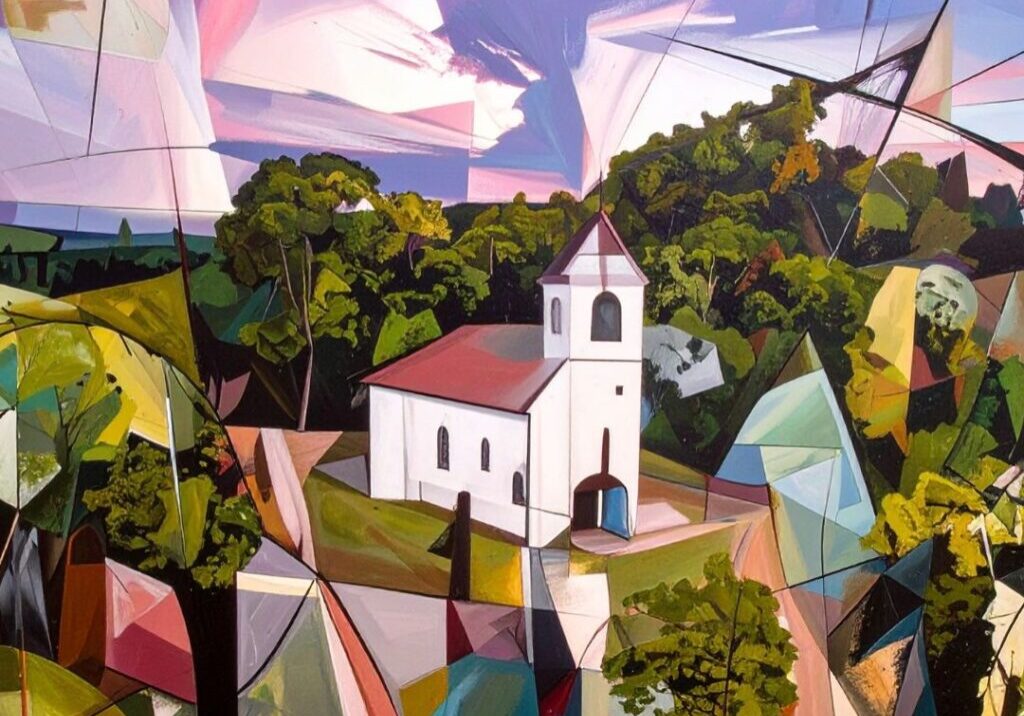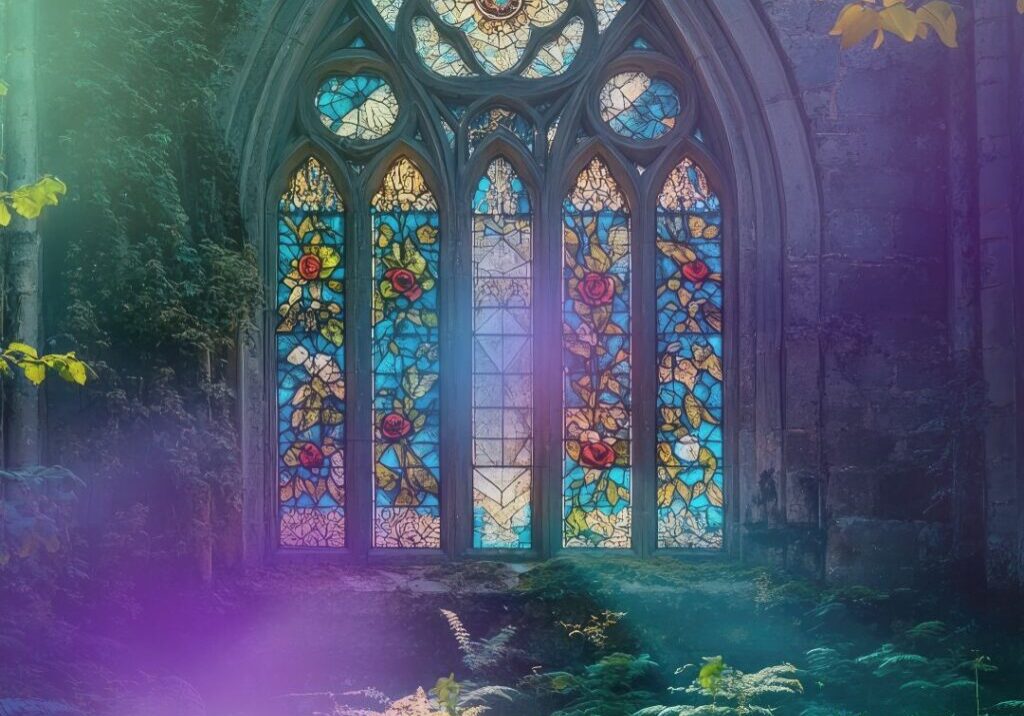Seeing Our Way Forward Through the Unifying Lens of Love
It’s a cold and foggy morning in western Kentucky. The colors are muted, and outlines of shapes and forms are increasingly blurred as you look towards the distance to a point where they seem to be only suggestions of forms; half-remembered dreams of identity and wholeness. The sky is a dull, monotonous glow, without differentiation, thus there is no defining context. The city could be anywhere. This scene brings to mind a poem called “Colorloss,” which I wrote in 1995 while watching the sun set.
Ducks darken into silhouettes, then disappear
as greens, blues, and whites merge into gray,
Leaving silver ridges that glide forward
on a monochromatic plane.
Flowers lose their hue and become indistinguishable
As they are absorbed into larger forms.A color-thief sun casts a farewell stripe
of bronze across the metallic pond
While the earth turns away from her fire.Nature must now animate herself
by her own memory of light and color
Until painted slowly again
by the sun’s glowing brush.And so I wait for you, O Love…
to paint me once again.
Little did I know that this experience of loss would be eerily similar to my experience of developing cataracts in my eyes almost three decades later, with the thief in this case being age. My research on cataracts prior to my surgery revealed that seeing is a complex and wondrous process. Simply put, light rays enter the eye through the cornea, pupil and lens. Photoreceptors (rods and cones) change light into energy that is transmitted as electrical impulses through the optic nerve to the brain where the impulses become images.[1]
Cataracts form when the proteins and fibers in the eye’s lens tissue break down. The cataract distorts the light that passes through the lens by scattering and blocking it, which prevents a clearly defined image from reaching the retina. Vision is blurred, colors are dimmed and often yellowed, and night vision is frequently impaired. During cataract surgery tiny instruments are used to break apart the cloudy lens, which is then removed and replaced with a clear, artificial, intraocular lens that becomes a permanent part of the eye.[2]
According to evolutionary cosmologist Brian Swimme, until about 600 million years ago life had developed without eyesight: “And there were great struggles, magnificent strategies, and soaring feelings, all within a blind world. And nowhere was there a vision of waterfalls, nowhere the experience of the blue sky, or the desert colors awakening in their first rain.”[3] He explains that the eye has been evolving continuously, along with the ear, the mind, the sense of touch and overall sensitivity, as life has become increasingly sentient.[4]
In discussing evolution, author Barbara Brown Taylor proposes that there lies a third alternative between Genesis and Darwin: “a creation dependent neither on a literal reading of the Bible nor on the random variations of genes, but on laws of complexity we are only beginning to understand.”[5] She continues, “Instead of a collection of genetic accidents, there are patterns more like blueprints that tend to organize cells the same basic way every time. These patterns explain why something as biologically complex as an eyeball can evolve in forty separate lineages.”[6] Water, for example, has its own dynamic of self-organization; “Stir the water and you get waves. Stir the gene pool and you get eyes, kidneys, spinal cords, and brains.”[7]
Clearly, the universe wants to see and be seen. Humans are the way that the universe sees itself with prophetic vision, made all the more powerful and promising when the imagination is ignited by love. While awaiting my first cataract surgery, with a second one on the other eye scheduled two weeks later, I reflected upon Advent seeing –waiting for restored vision; waiting to be transformed by a more colorful, focused and vibrant vision of the Christic whole. For, as the prophet Isaiah envisioned, “then the eyes of the blind shall be opened,”[8] to the ‘peaceable kingdom’ of the Christ as the teleological focal point. Seemingly opposite yet complementary members of the whole will move towards unity ahead as they pass through the lens of love, for multiplicity in unity is the pattern for Christic seeing:
The wolf shall live with the lamb,
the leopard shall lie down with the kid,
the calf and the lion and the fatling together,
and a little child shall lead them.
The cow and the bear shall graze,
their young shall lie down together;
and the lion shall eat straw like the ox.
The nursing child shall play over the hole of the asp,
and the weaned child shall put its hand on the adder’s den.
They will not hurt or destroy on all my holy mountain;
for the earth will be full of the knowledge of the Lord
as the waters cover the sea.[9]
After my first cataract surgery I was deeply moved, not only by the increased clarity of seeing, but also by the vivid colors – colors I hadn’t seen since I was a teenager. And with the restored colors came recovered memories; things I hadn’t thought about for years, such as the colorful lights of a Christmas tree reflected in shiny wrapping paper, or psychedelic posters hanging on the walls of the Spencer’s store at the mall where my friends and I hung out. Regaining my sight has helped me to become like a child again, seeing a new beauty and wholeness of life and fueling the imagination. With a richer palette and clearer focus, I am able to remember and draw upon a fuller spectrum of possibilities for teleological seeing as I contribute to a larger collective vision. For, as the prophet Isaiah foretells, “Then the glory of the LORD shall be revealed, and all flesh shall see it together…”[10] Love is the focusing lens through which we are drawn together in unity, re-membering who we are as part of the whole.
Ilia Delio proposes, “…the completion of creation is the fullness of God (cf. 1 Cor 15: 28).”[11] She draws upon Teilhard’s description of the incarnation as “creative union,” which is “a process of imminent unification in which Christ is in process of being created by the gradual unification of multiplicity. Thus “creation” is to be located not at the “beginning” of the world, but as its “end.”[12] Christ, then, is the focal point at the back of the eye, the image created in the brain, as well as the process of seeing itself. Delio continues, “The involvement of God in evolution through creative union means that everything happens as though the One were formed by successive unifications of the multiple, and as though the One were more perfect the more perfectly it centralized under itself a larger multiple. The One appears to us only in the midst of the multiple, dominating the multiple, since its essential act is to unite. God is revealed everywhere as a universal milieu, only because God is the ultimate point upon which all realities converge.”[13]
Love is the power of Christic unification. In his first letter to the Corinthians St. Paul writes, “For we know only in part, and we prophesy only in part; but when the complete comes, the partial will come to an end. … For now we see in a mirror, dimly,[14] but then we will see face to face.”[15] Delio ends her book, The Primacy of Love, with the words, “Through the eyes of love, we see the face of God.”[16] All of creation will be in that face. Our task, then, is to turn towards one another in love, so that we may see our way forward together, following the star that leads to Emmanuel – God with us and “God-with(in)-us.”[17] In her Christmas reflection Delio invites us to place a mirror in the manger, bend low to see our face within it, and be born anew as God-bearers.[18] Thus, our forward gaze may be directed inward or outward, for epiphany occurs in all directions as we come to see ourselves in Christ and Christ in us.
Reference Notes:
[1] American Academy of Ophthalmology. https://www.aao.org/eye-health/anatomy/parts-of-eye.
[2] Mayo Clinic, “Cataracts,” https://www.mayoclinic.org/diseases-conditions/cataracts/symptoms-causes/syc-20353790.
[3] In Thomas Berry, The Dream of the Earth, (San Francisco: Sierra Club Books, 1988), vii.
[4] The Dream of the Earth, viii.
[5] Barbara Brown Taylor, The Luminous Web: Essay on Science and Religion (New York, NY: Cowley Publications, 2000), 24.
[6] Ibid.
[7] Ibid.
[8] Isaiah 35:5, NRSV
[9] Isaiah 11:6-9, NRSV.
[10] Isaiah 40:1-11, NRSV.
[11] Ilia Delio, The Emergent Christ (Maryknoll, NY: Orbis Books, 2011), 47.
[12] Ibid.
[13] Delio, Emergent Christ, 48.
[14] Also interpreted as “in a riddle.” See footnote b at https://www.biblegateway.com/passage/?search=1%20Corinthians%2013&version=NRSVCE#fen-NRSVCE-32934b.
[15] 1 Cor. 13:9-10, 12, NRSV
[16] Ilia Delio, The Primacy of Love (Fortress Press: Minneapolis, 2022), 82-83.
[17] Francisco Burgos, Executive Director of Pendle Hill Quaker Retreat Center, In “The Joy and the Provocation of “God-With(in)-Us” Burgos translates “Emmanuel” as “God-with(in)-us.” See https://pendlehill.org/the-joy-and-the-provocation-of-god-within-us/.
[18] Ilia Delio, https://christogenesis.org/who-is-in-the-manger/.
 View print-friendly version
View print-friendly version
10 Comments
Related Posts

Beyond Violence: The Path Through Grief to Spiritual Evolution
The recent shooting at Annunciation School in Minneapolis continues to haunt our collective consciousness. While the news cycle moves forward—with yet more senseless acts of political violence—the Annunication tragedy leaves…


Oh, it’s you, Kay! Thanks so much for your generosity! And I love your username!
Emily, you always have permission to share!
Thank you!
Kay Jackson
Astralstar, thank you so much for this very beautiful and rich reflection, which brings us deeper into the mystery of seeing. And thank you for the lovely prayer as well. May I have permission to share it?
Seeing and sight are apt descriptors for awakening consciousness. The lamb with the lion, the child playing over the asp hole have a surface meaning and a deeper meaning requiring the stripping of personal “onion” layers and the “focusing” on the hidden complexity within.
Certain “thin” places and thin, liminal, evolutionary moments all have the capacity to open the eyes of those ready to see.
This past year I have been studying comparative religion and was fascinated to learn of the Dogon. An indigenous African religion who found the Sirius star, and its companion, millennia before any “artificial” technology. How? Observation of other stars since Sirius is not directly observable. Talk about sight being applied to opening an “onion peel!”!
In so many ways, I find that our desire to know and love this God is asking us to reflect on our Ancestors. Especially those in Africa. How did they know? They naturally intuited a Supreme God. All around these indigenous folk was beauty and plenty. Surely an
“Absolute Architect” was at play. A Supreme God within nature. Granted, there were many “denominations” but there were many shared beliefs.
Our Ancestors( capitalized for honour) used their technology, their eyes and other senses to make sense of the world and found God. Words, labels, practices, did not stop their pursuit of God. Their sight led them.
May our sight lead us. May we not be held back from seeing and awakening to a deeper consciousness, a consciousness we may already have, but is deeply dormant from inaction.
May our sight be focused on creating harmony.
Paul, thanks so much for taking the time to read my work and respond (such a good brother!). I’m glad you liked the poem. (There’s a lot more where that came from!) You mentioned Matthew Fox. I read his book on the Cosmic Christ years ago with great interest. More recently, I’ve read Richard Rohr’s work on the Universal Christ and am currently immersed in Ilia Delio’s work. Sr. Ilia’s work has rekindled a desire for me to go back and read Teilhard again, this time as a woman late in life, rather than a teenager. I highly recommend Sr. Ilia’s work. Since you are interested in the Christ, you might begin with “Christ in Evolution” and “The Emergent Christ.” I think you would enjoy them, and I’d be happy to discuss them with you! Or you may want to join one of our Christophany groups who are exploring Sr. Ilia’s work. If so, let me know.
Hilda, thank you for your kind words. I too have marvelled at the wonder of sight and now have an even more complex understanding of it, which has only increased since writing this piece. As I was saying to Joe, I am reading a book entitled “Sentient, How Animals Illuminate the Wonder of Our Human Senses,” by Jackie Higgins (2021). The first three chapters relate to seeing. I am still pondering the new information and intend to theologize about these new understandings in the future,through a Teilhardian/Delio lens. I find that as my knowledge increases, so does my idea of God.
I was really impressed with your poem, it is very beautiful. You really brought out the complementarity of religion and science; they are like two different lenses and what they see is somewhat different but they ultimately resolve into a single reality. The references to Christ reminded me of Matthew Fox and his ideas. I am glad that your cataract surgery went well and you can see clearly again.
Thank you, Emily, for this reflection on the wonder of seeing! It is something I have marvelled at for a long time, and I wondered how and when nature developed this almost universal faculty of all living creatures. And together with that, of course, the wonder of light itself! Such an amazing combination, light and eyes to receive it. I enjoyed your celebration of this amazing phenomenon, and rejoice that modern medecine has restored its fulness to you. Your poem is very beautiful. Hilda Geraghty
Joe, thank you for your very beautiful response. I always appreciate it when you give us more to think about. Thank you.
After writing this piece, I learned more about seeing from the chapter entitled “The Peacock Mantis Shrimp and Our Sense of Color,” of Jackie Higgins book, “Sentient, How Animals Illuminate the Wonder of Our Human Senses.” She has two additional chapters related to seeing, which I look forward to reading.
Thank for this column, Emily, and for your experiences in seeing, literal and spiritual. As pure light contains all colors, and pure love all virtues, so pure consciousness (single eye vision) sees God as one, diffracted in all things as from a prism. “The unifying force of the multiple cannot be composed oh the multiple” — Teilhard de Chardin.